The one arm overhead dumbbell extension promotes the development of symmetrical triceps as well as muscular triceps by making you lift each weight in a unilateral fashion.
While training unilaterally certainly makes your workouts longer, the one arm dumbbell tricep extension is nevertheless an invaluable exercise for reducing your upper arm muscular imbalances because it ensures that both of your triceps receive equal work.
This guide shows you how to do a single arm tricep extension with the optimal muscle-building form and then discusses the benefits and drawbacks of the exercise.
One arm overhead extension exercise details
- Also Known As: 1 arm tricep extension, one hand tricep extension
- Main Muscles: Triceps
- Exercise Type: Strength
- Exercise Mechanics: Isolation
- Difficulty Level: Beginner
- Equipment Needed: Dumbbell
How to do a single arm tricep extension
- Grab a relatively light dumbbell with a neutral grip, and then press the weight over your head.
- Tuck your elbow in slightly, and then lower the weight behind your head by breaking at your elbow.
- Descend until your forearm makes firm contact with your biceps (or until you feel an intense triceps stretch).
- Reverse the motion by flexing your triceps muscle forcefully.
- Keep going until your elbow reaches full extension.
- Perform 3-5 sets of 10-20 reps in total.
One arm tricep extension advantages
The one arm tricep extension does a lot more than build mass (though it’s an excellent exercise for gaining size as well). If you want your upper arms to look more aesthetic and proportional, then the single arm extension is one of the best exercises for the job.
It enhances your triceps symmetry
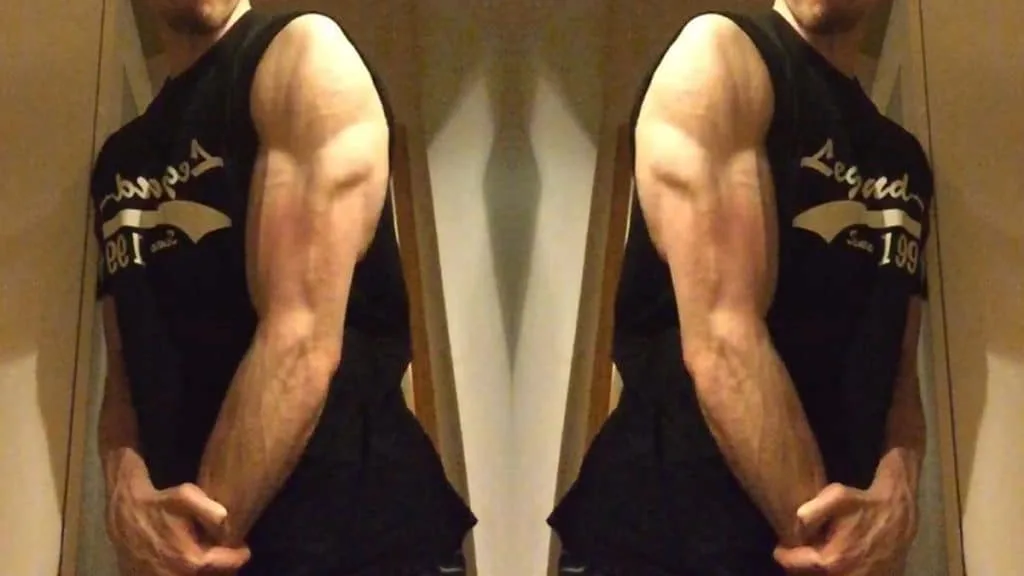
Performing a dumbbell one arm tricep extension means that you have to lift each weight separately. [1]
This unilateral training style, in turn, means that both of your triceps muscles are getting equal amounts of stimulation and thus growing in proportion.
Muscle symmetry is particularly important if you’re a physique athlete or are training to become one in the future because judges award top place finishes to those with the best overall body, not just the competitors with the most mass.
Improving your triceps symmetry will make your arms look more aesthetic without them actually becoming any bigger. All you’ve got to do is perform some unilateral isolation exercises after your heavy compound lifts.
In a similar vein, the one arm dumbbell extension can improve the mind-muscle connection that you have with your weaker arm. This improvement makes your compound movements (not just your isolation exercises) more effective because when you can activate both of your triceps relatively equally, they’re naturally going to perform a similar amount of work, which means that the bar won’t become lopsided during the bench press, for example.
It promotes greater triceps strength
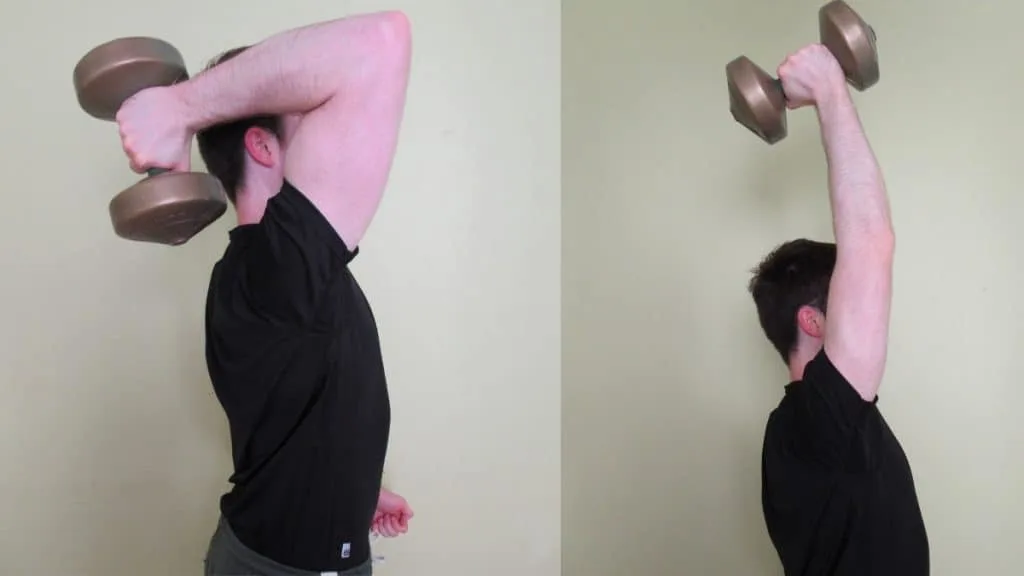
While lifting two dumbbells over your head at the same time isn’t exactly what you’d call challenging, lifting one weight at a time is even easier.
In other words, moving one limb is an easier task for your brain than moving two limbs.
This means that your triceps get the full benefit of your strength and energy because when you do the one arm overhead extension, your focus isn’t split over two limbs.
Compared to lifting two separate weights together, you’ll naturally be stronger when you do one arm dumbbell extensions.
While the strength increase may only be a few pounds, it’s still a free and instantaneous strength increase, which demonstrates just how effective unilateral exercises are if you’re willing to spend the time to do them.
It promotes good technique
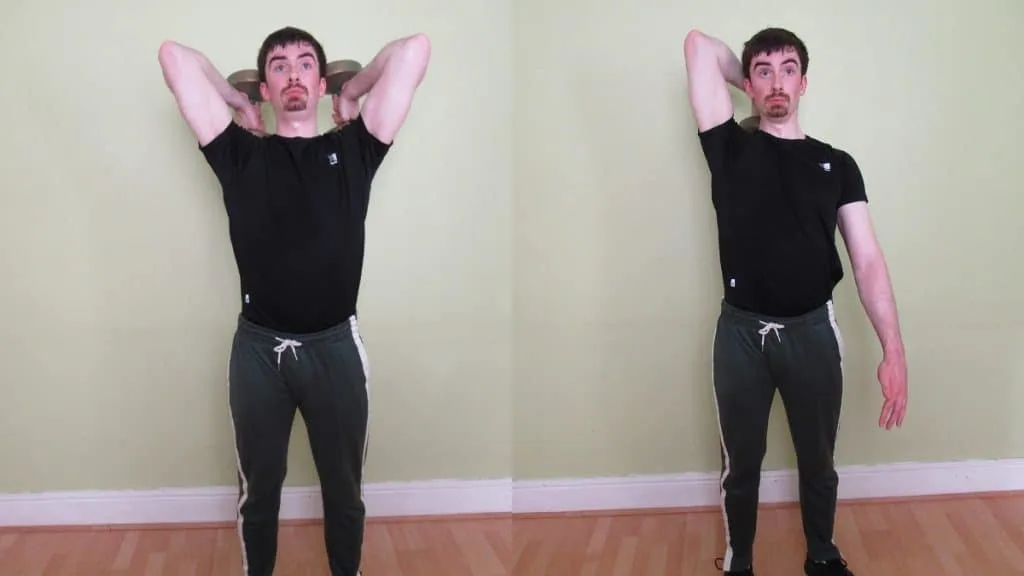
As mentioned, it’s much easier to focus on moving one limb than on moving two limbs. This means that the one arm overhead tricep extension naturally promotes (though it doesn’t guarantee) good technique because it’s easier to keep your elbow in the correct position.
Just what is this “good technique” that I’m referring to?
Essentially, you want to put your shoulder into the highest possible degree of flexion because this is the position in which the largest head of the triceps—the long head—is the most active.
Additionally, while some elbow flare is okay, your elbows shouldn’t be flared straight out to the sides. Ultimately, though, when it comes to elbow positioning, the most important things are a) that you don’t feel any joint pain and b) that your triceps are getting a good eccentric stretch.
It’s much more straightforward to monitor your technique and feel your triceps working to their maximum capacity when you only need to think about moving one arm. This is the main benefit of single arm extensions.
It’s highly convenient
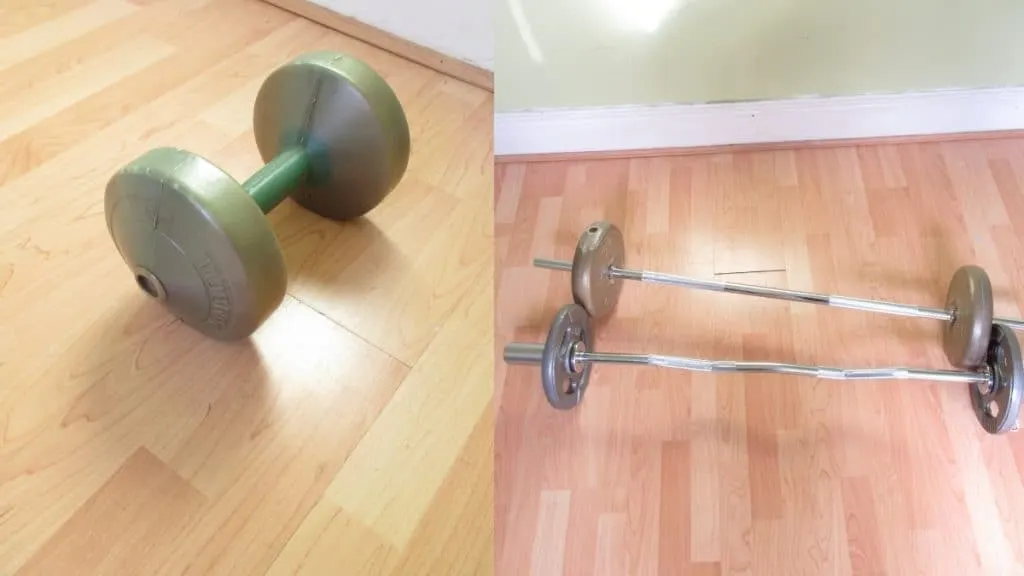
Unlike similar exercises, which often require a bar and weights (or at the very least two dumbbells), the one arm overhead extension requires nothing more than a single dumbbell.
As such, it’s the ideal exercise for those who train at home because you don’t need a massively heavy dumbbell when you’re working each arm separately.
Conversely, if you were to opt for the two-arm version of this exercise, then you’d need a dumbbell of roughly double the weight, which isn’t practical for many people who work out at home.
One arm dumbbell extension disadvantages
The single arm dumbbell tricep extension is undeniably effective for sculpting muscular and symmetrical triceps. Yet, there are three significant drawbacks of the exercise that you need to consider before including one arm extensions in your arm routine.
It makes your workouts longer
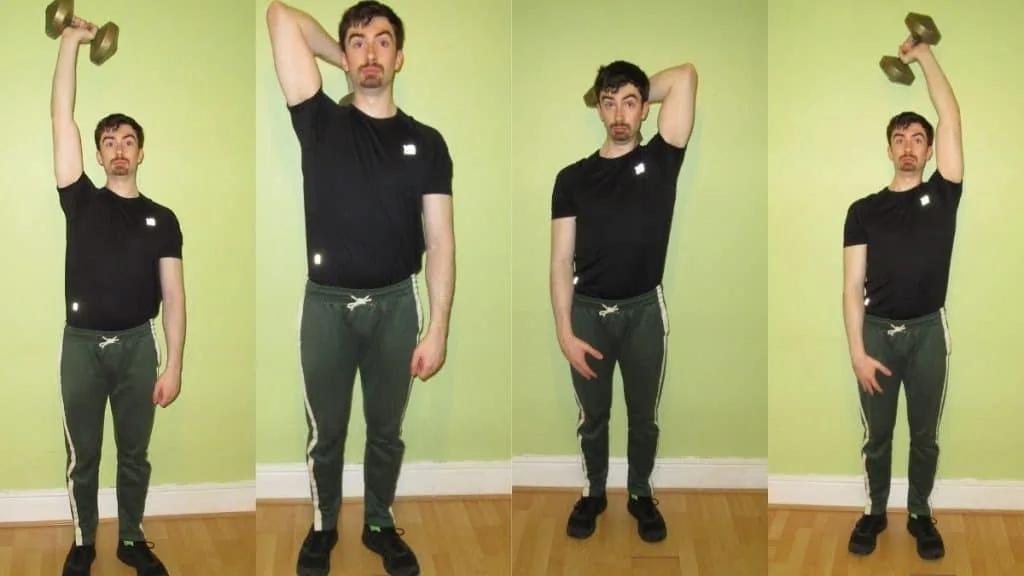
There’s no getting around the fact that unilateral exercises slow down your workouts.
But would you rather be the lifter with enviable aesthetics or the guy who’s in and out of the gym in half an hour?
If you’re new to weight lifting and don’t yet have the triceps size to make the symmetry apparent, then you’re best off sticking with two-arm exercises until you’ve built a solid foundation of mass.
But if you passed the novice lifter stage a long time ago and have the tight t-shirt sleeves to prove it, then it could be well worth spending some extra time in the weight room to sculpt triceps that are more symmetrical.
Increasing the resistance is harder
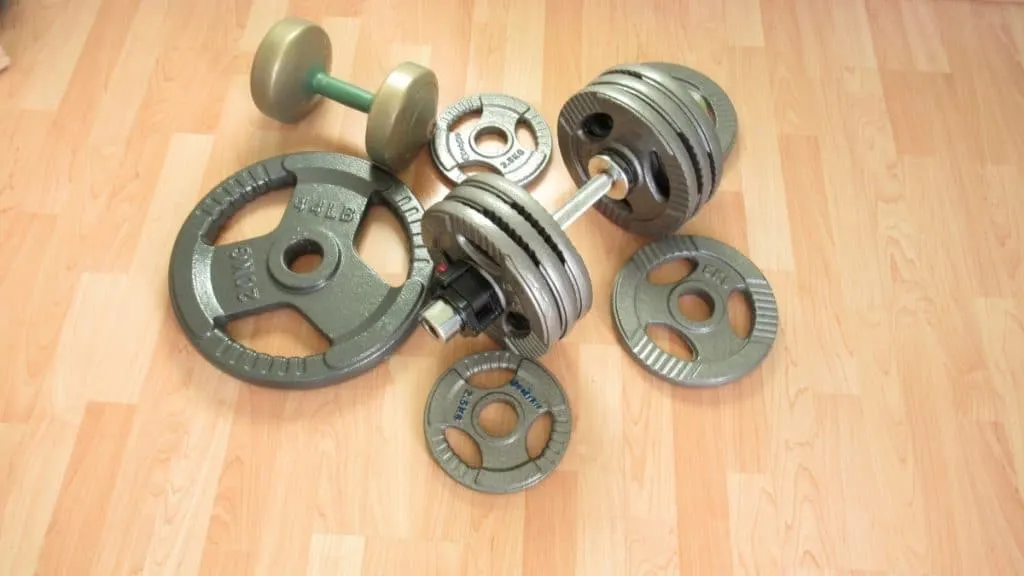
While lifting one weight at a time rather than a dumbbell in each hand makes you stronger (since you don’t have to split your focus over two limbs), it doesn’t actually make gaining strength any easier.
If you have to increase the resistance by 5 lbs to graduate to the next dumbbell, then that’s a per arm increase.
On the contrary, if you opt for the two-arm version, then a 5 lb weight jump would be the equivalent of a 2.5 lb per arm increase.
So if you want to gain strength as quickly as possible, then the one arm triceps extension is actually suboptimal.
But as luck would have it, you can, in fact, have it both ways.
You could do the single arm overhead extension during one workout and perform the two-arm variation in another session. This way, you’re training your triceps with a likely optimal twice-weekly frequency while getting the best of both overhead exercises.
It could hurt your shoulders
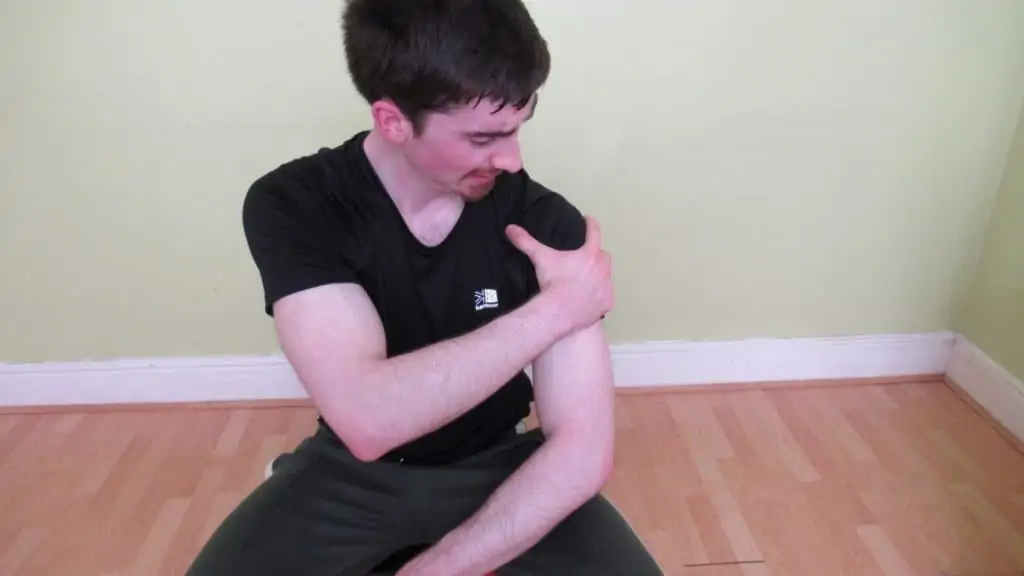
If you have deltoid pain after tricep extensions, then you’ll need to work on your shoulder mobility or perform lying exercises instead. [2]
Most people don’t have such a problem, but if you’ve wrecked your rotator cuffs from years of improper bench pressing, then you might not be able to get your arms all the way behind your head, which would reduce the effectiveness of the single arm overhead tricep extension.
Training unilaterally can often help because, as mentioned, it’s simply easier to keep your shoulder in the correct position when you only need to move one side of your body.
One arm extension variations

Any tricep extension that doesn’t involve a barbell can be performed in a unilateral fashion. The guides below discuss each variation in detail and have a section dedicated to the one-arm version of that particular exercise.
- One arm overhead cable tricep extension
- Kneeling tricep extension
- Front to back tricep extensions
- One arm kettlebell overhead extension
- Plate tricep extension
- Resistance band tricep extension
- One arm seated dumbbell extension
- Overhead reverse grip tricep extension
- Lunge with tricep extension
Single arm overhead tricep extension workout recommendations
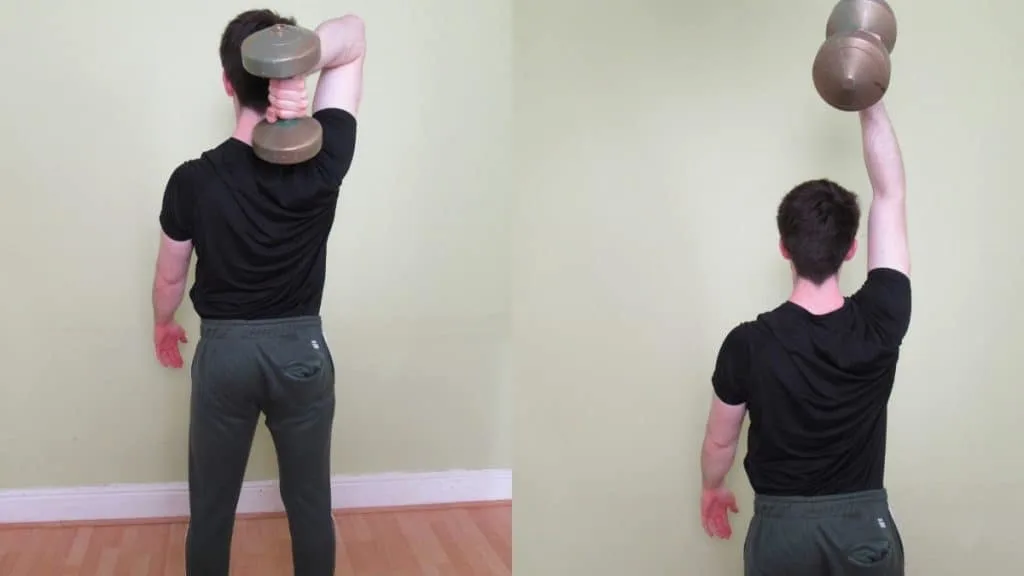
Perform 3-5 sets of the one arm dumbbell triceps extension per workout and aim to do the exercises around twice a week.
As for reps, sets of 10-20 repetitions are your best bet.
While it’s possible to perform and even thrive from lower reps, the single tricep extension places a lot of torque through your elbows joints, so lifting as heavy as possible isn’t recommended.
If you have overhead tricep extension elbow pain, then high rep training can be a good workaround.
While performing high reps can certainly produce excellent gains, such a training style is very intense and leads to far higher levels of systemic fatigue than moderate repetitions, especially when the sets are taken to failure. [3]
For most lifters, then, sets of 10-15 reps are the sweet spot for the dumbbell one arm triceps extension.
Conclusion: Should you do the dumbbell one arm triceps extension?
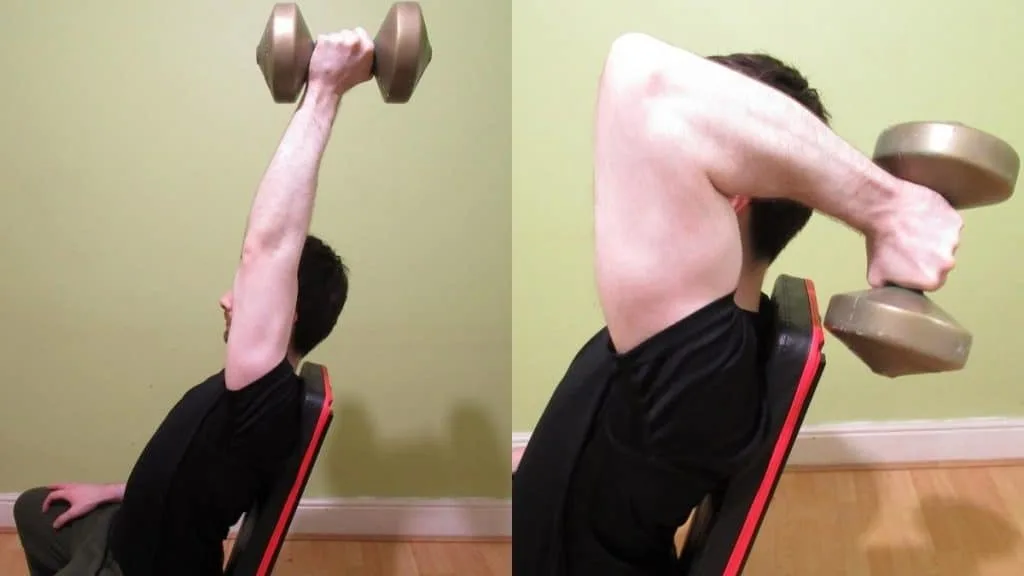
Nobody can deny the muscle-building and symmetry-sculpting effectiveness of the single arm tricep extension. Yet, just because a particular exercise produces results (and many exercises do) doesn’t mean that you should include it in your workout routine.
After all, if you did every exercise that was good (or attempted to), then you’d quickly become overtrained.
If you’re a novice lifter who lacks the mass to make any kind of symmetry apparent, then you’re better off sticking with bilateral exercises for the time being.
On the other hand, if you’ve been lifting for years and have good arm development but lack triceps symmetry, then it’s a smart idea to make the one arm dumbbell extension part of your program.
The knock-on effect of single arm dumbbell extensions is significant. Not only will the single arm dumbbell extension reduce your muscular imbalances, it’ll also help you to press the barbell more evenly during your compound lifts, which will further equalize the amount of stimulation that your triceps are receiving.
References
- Fountaine, C. J. (2018). Unilateral And Bilateral Exercise Movements. ACSM’S Health & Fitness Journal, 22(3), 11–16. https://doi.org/10.1249/fit.0000000000000390
- Long, Z. (2021, June 23). The 8 Best Drills to Unlock Your Shoulder Mobility. The Barbell Physio. https://thebarbellphysio.com/8-best-drills-unlock-shoulder-mobility/
- Sánchez-Medina, L., & González-Badillo, J. J. (2011). Velocity Loss as an Indicator of Neuromuscular Fatigue during Resistance Training. Medicine & Science in Sports & Exercise, 43(9), 1725–1734. https://doi.org/10.1249/mss.0b013e318213f880

